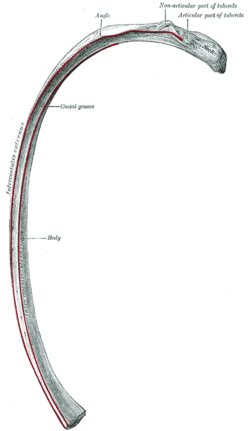Neck of rib
| Neck of rib | |
|---|---|
 | |
| A central rib of the left side. Inferior aspect. (Neck visible at upper right.) | |
 | |
| A central rib of the left side, viewed from behind. (Neck visible at upper right.) | |
| Latin | collum costae |
| Gray's | subject #28 124 |
The neck of the rib is the flattened portion of a rib bone which extends laterally from the head; it is about 2.5 cm. long, and is placed in front of the transverse process of the lower of the two vertebræ with which the head articulates.
Its anterior surface is flat and smooth, its posterior rough for the attachment of the ligament of the neck, and perforated by numerous foramina.
Of its two borders the superior presents a rough crest (crista colli costœ) for the attachment of the anterior costotransverse ligament; its inferior border is rounded.
On the posterior surface at the junction of the neck and body, and nearer the lower than the upper border, is an eminence—the tubercle; it consists of an articular and a non-articular portion.
- The articular portion, the lower and more medial of the two, presents a small, oval surface for articulation with the end of the transverse process of the lower of the two vertebræ to which the head is connected.
- The non-articular portion is a rough elevation, and affords attachment to the ligament of the tubercle. The tubercle is much more prominent in the upper than in the lower ribs.
Additional images
-

Costovertebral articulations. Anterior view.
-

Costotransverse articulation. Seen from above.
This article incorporates text from a public domain edition of Gray's Anatomy.
| ||||||||||||||||||||||||||||||||||||||